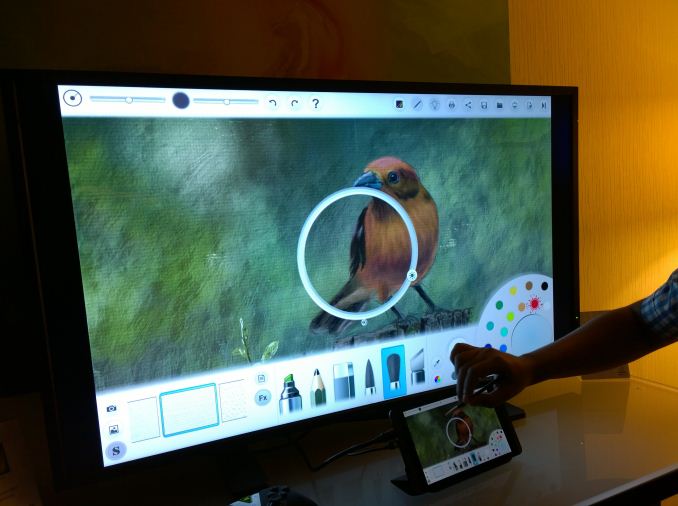NVIDIA Launches Shield Tablet
by Joshua Ho on July 22, 2014 9:00 AM EST
Today, NVIDIA is announcing the Shield tablet. While normally such launch announcements don’t require much in the way of exposition, NVIDIA is in an odd place. Last year, the Shield portable and Tegra Note 7 were the primary mobile devices shipping with Tegra 4. In hindsight, the Shield portable was a bit too niche to ever reach mass adoption. It was first and foremost a gaming device, with a display attached to a controller as opposed to a controller attached to a display. The result was that while it was surprisingly good for gaming, it wasn’t the best tablet. It really only worked in landscape mode, the display size was relatively small (5 inches diagonal), and using the touchscreen was an awkward experience.
The Tegra Note 7 was NVIDIA’s attempt at competing in the mainstream tablet market. While the dual front facing speakers and stylus were good advantages over the Nexus 7, it wasn’t clearly better than the Nexus 7. The display was lower resolution, lower contrast, and not as well calibrated. The WiFi module only supported 2.4 GHz, and there was only a gigabyte of RAM. While it was possible to emulate a Shield-esque experience with the Note 7, there was no game streaming from PC to tablet due to the lack of 5 GHz WiFi, and the controllers on the market simply weren’t as good as the controller in Shield. In addition, because the Tegra Note 7 wasn’t directly controlled by NVIDIA the experience in software update speed could vary.
From the lens of past experience, the Shield tablet makes a lot of sense. The specs are right for a good tablet, but it’s also a proper Shield device. As a tablet, it has all the right pieces. A high resolution display, Tegra K1 (Cortex A15 variant), dual front facing speakers and bass reflex ports, a new stylus, 5 GHz WiFi, and a 5MP front facing camera. I’ve put a table of the specs below for easier reading.
| NVIDIA SHIELD Tablet | |
| SoC | Tegra K1 (2.2 GHz 4x Cortex A15s) |
| RAM/NAND | 2 GB DDR3L-1866, 16/32GB NAND + microSD |
| Display | 8” 1920x1200 IPS LCD |
| Network | 2G / 3G / 4G LTE (NVIDIA Icera i500 UE Category 3/4 LTE) |
| Dimensions | 221 x 126 x 9.2mm, 390 grams |
| Camera | 5MP rear camera, 1.4 µm pixels, 1/4" CMOS size. 5MP FFC |
| Battery | 5197 mAh, 3.8V chemistry (19.75 Whr) |
| OS | Android 4.4.2 |
| Connectivity | 2x2 802.11a/b/g/n + BT 4.0, USB2.0, GPS/GLONASS, mini HDMI 1.4a |
| SIM Size | None or MicroSIM |
In the stylus side, DirectStylus 2 is said to reduce the inking latency to half that of the implementation we saw in Tegra Note 7. In practice it seemed that the stylus latency was low and lines tracked closely to the stylus, but I’ll avoid final judgment until the review. NVIDIA also claims that there are more levels of pressure sensitivity, but it’s not quite clear how many levels there are. NVIDIA has also added handwriting recognition software, which worked relatively well in some casual testing. The Dabbler application also seems to provide a relatively realistic simulation of various physical mediums such as oil painting and watercolor, although it’s mostly targeted towards artists.
In addition to the stylus features, NVIDIA is advertising 1080p Netflix support. Normally, due to the DRM restrictions associated with high bitrate streaming, most Android devices only support low resolution streams. NVIDIA has done all of the necessary work to satisfy these DRM requirements, so it supports the highest bitrate available to mobile devices. Of course, this feature will be disabled with an unlocked bootloader, but it’s a good feature to have for mobile streaming.
Outside of tablet features, the gaming features seem to be quite compelling. The controllers themselves were comfortable, and were very similar to the Shield portable’s ergonomics. NVIDIA is emphasizing that these controllers connect over WiFi direct, and the frequency selected depends upon the network that is used. The result is much lower latency, and NVIDIA is also able to run a headset jack and microphone through the controller due to the higher bandwidth that WiFi provides. Up to four controllers can be paired to the Shield tablet for multiplayer games.
Due to the addition of 5 GHz 2x2 WiFi, NVIDIA’s GameStream and GRID, which means that it’s possible to stream games from a PC within the same LAN to Shield tablet and play games by streaming from NVIDIA servers to the tablet. NVIDIA did note that only 720p is supported through WiFi, and an Ethernet connection is necessary to stream at 1080p due to latency reasons.
While both GameStream and GRID are largely similar in experience compared to the Shield portable, the Kepler GPU in the Tegra K1 enables a great deal of potential for gaming. Trine 2 will ship with the tablet, and is a direct port from the console game. NVIDIA also showed off the improvements in games like Half Life 2 and Portal, which run full OpenGL rather than OpenGL ES as it did on Shield portable. Outside of feature set, NVIDIA is claiming that the K1's GPU is far faster than the GPU in either the Exynos 5420 or Apple's A7 SoC.
In addition, NVIDIA showed off a full version of War Thunder running on Shield tablet, and claimed that it will be able to play on multiplayer with PCs. This included both the tank and aircraft combat aspects of the game. NVIDIA also showed that the Unreal Engine 4 demo from Google IO runs on the Shield tablet.
Finally, the Shield tablet will be the first Android tablet to support streaming to Twitch. By leveraging the built in front facing camera, it’s possible to stream both gameplay and webcam/commentary. In practice, I didn’t see any noticeable issues with this system, and it seemed to work as promised. The 1.4 micron pixel size seemed to make the quality relatively acceptable even indoors.
That was a lot to go over, but I think the key here will be the native gaming experience on Shield tablet. While it’s fully possible for Shield tablet to serve as a dedicated console with GameStream, the real use case will be whether it can provide a solid gaming experience using the SoC for rendering rather than as a video decoder for a PC somewhere else. With games like War Thunder and Trine 2, it seems that there is immense potential for a very compelling product. While NVIDIA isn’t starting from nothing this time around, this ecosystem aspect is still a bit risky.
The Shield tablet will go on sale July 29th for the US, August 14th for Europe. The 16GB/WiFi variant will cost 299 USD, the 32GB/LTE variant will be 399 USD. The controller is priced at 59 USD, and the flip cover at 39 USD.















107 Comments
View All Comments
betam4x - Tuesday, July 29, 2014 - link
bro, while i'm not necessarily in agreement with anyone else...however you are the clueless guy. Android = Linux. Linux has a far greater hardware/software following than Windows. Just because *you* can't make it work doesn't mean it doesn't work. Just saying.lmcd - Tuesday, July 29, 2014 - link
Android == Linux but Android !===Linuxthere's a reason tons of work was needed to bring real Linux C/C++ libraries in
there's a reason there's an Android Graphics Extensions
there's a reason kernels are all custom
Linux sucks for mobile hardware, and likely will for a while.
Ktracho - Tuesday, July 22, 2014 - link
I, too, bought a Surface Pro 3 for my daughter who is going to college in the fall. So how much did yours cost? How well does it do when you play your favorite games on it?chizow - Tuesday, July 22, 2014 - link
Nice! I'm sure your daughter will love it. I actually bought mine mainly for my wife who is also going back to school this fall. We originally got her an Asus T100 for the task, but it wasn't quite polished or fast enough for her to be fully satisfied with it. The stylus was the kicker in that respect, but the typepad is also better overall than the T100's mini-keyboard. OneNote and PowerPoint with the Stylus is an absolute game-changer for taking notes, I wish this tech was available when I was in school!I actually haven't tried playing any games on it, but I've read the SP3 handles gaming decently. I'd probably only run Diablo 3 on it to 2-box since that's what I've played the most recently, and I had read the i5 HD4400 runs that with no problems at all. We paid $900 (price matched to Microsoft store) + add'l 10% back in rewards from Best Buy for the i5/128GB variant. Staples also had a 15% off tech coupon this weekend that worked on Surface Pro 3 with an additional 10% rewards from BoA. It is definitely more costly than anything in the Android space, but it also is capable of a ton more too. Very happy with the device, price point is still a bit high, but Microsoft addressed my main gripes about SPro 1/2 (battery life, thickness, screen size).
nevertell - Tuesday, July 22, 2014 - link
Well, streaming from a home pc to WAN will never be a mainstream option, as rarely anyone has a static IP, especially gamers who would actually buy a tablet like this. You could make a case for having a dyndns-like service provided by Nvidia, but the fact is, most ISP's in the States and in most of the financially developed countries in Europe are utter crap.chizow - Tuesday, July 22, 2014 - link
@Nevertell, this is probably in response to my request to have streaming enabled from my PC to WAN, it's actually not an issue as long as you have software/firmware on both ends to dynamically handle IPs/hostnames. My Home NAS handles this seamlessly and only uses a web-based authentication system which handles all the IP/hostname handshaking.nevertell - Friday, July 25, 2014 - link
But you won't get a stable uplink from your regular consumer ISP, especially if you do not live right next to a junction box or you have loads of other clients sitting on the same line.Morawka - Tuesday, July 22, 2014 - link
The Technology for streaming your pc games to a tablet is already here. We've been capable of this for over 2 years now, it's just america's horrible internet that holds everything back. And it's not going to get better anytime soon.A optimistic estimate would be 15 years from now. Sure nvidia could make datacenters closer, but we need internet that's capable of 5 Mbps UP AND DOWN and quite simply, only 3-4% of people have a 5 Mbps Upload capability.
chizow - Wednesday, July 23, 2014 - link
Well it would obviously be limited to QoS/Bandwidth requirements dependent on ISP, same as GRID being limited to certain markets, or GameStream requiring 5GHz, but yes the underlying tech has been there, it just hasn't been enabled. This would be the game-changer imo for Shield and really differentiate it from consoles and handhelds.I've had access to 5Mbps upstream for nearly a decade and my current ISP (FiOS) has me at at 75/50. Many public WiFi hotspots in my area (Panera, Starbucks etc.) also have at least 15Mbps up and 5GHz WiFi, although I'm not sure they would sustain those speeds when shared among multiple users.
Morawka - Tuesday, July 29, 2014 - link
cell sites offer fast speed but price per GB is outrageus. $15 per GB.The LTE speeds severely break down when there are over 50 people pegging their network.
that is, unless you live in a over populated, area full of smog, noise and light pollution.